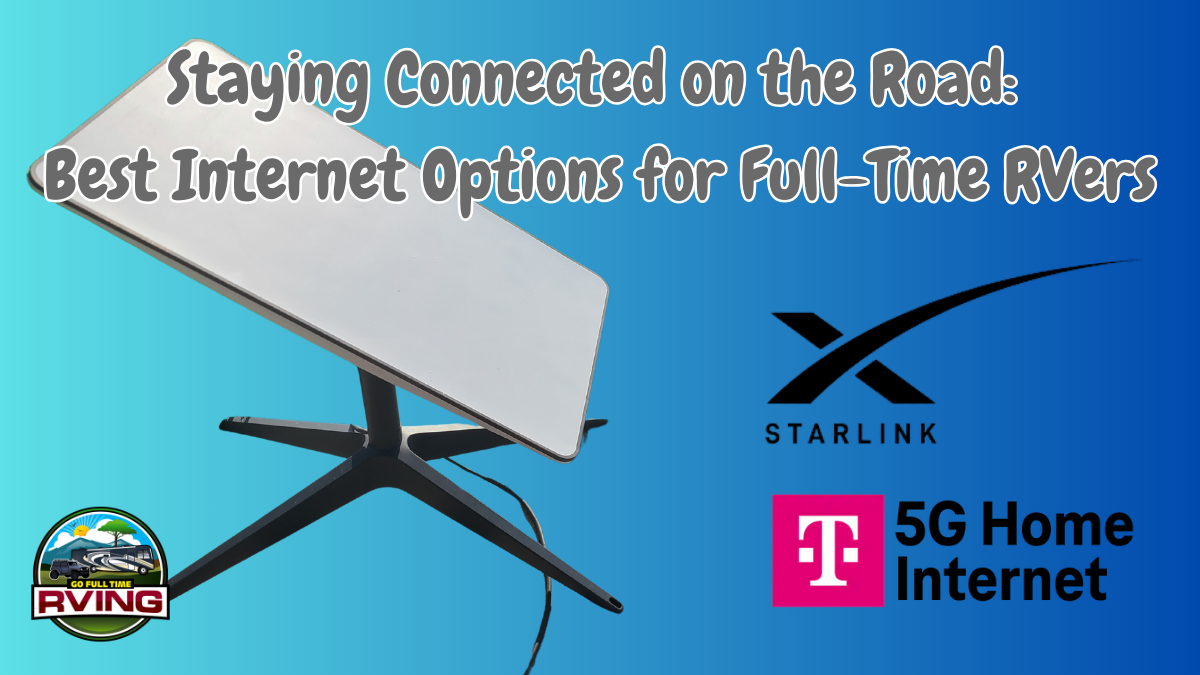One of the first questions people ask us about full-time RV living is: “How do you stay connected on the road?”
The truth is, having reliable internet has become just as important as water, electricity, and propane for RVers. Whether you’re working remotely, streaming Netflix, video chatting with family, or running an online business, you need more than the campground’s “free Wi-Fi” sign to keep you connected. In this post, we’ll cover the best internet options for full-time RVers.
Over the years, Lisa and I have tested nearly every option—hotspots, MiFi devices, campground Wi-Fi, and even satellite internet. Today, our setup is a mix of T-Mobile Home Internet, our T-Mobile phones, and Starlink. Here’s what we’ve learned (sometimes the hard way) about staying online while living in an RV.
This post contains affiliate links. As a participant in Amazon Associates and various affiliate programs, we are compensated when qualifying purchases are made through our referral links at no additional cost to you. Full Disclosure
Why Campground Wi-Fi Rarely Works
Let’s be honest—campground Wi-Fi has a bad reputation, and for good reason.
On paper, it sounds great: free internet included with your nightly stay. But in practice, it’s usually a frustrating experience. Here’s why:
- Overloaded Networks: Most RV parks were never designed to handle hundreds of people streaming Netflix, running Zoom meetings, and uploading YouTube videos at the same time. When the park fills up, the system crashes.
- Weak Coverage: If your site is far from the router, your signal strength drops dramatically. Sometimes you can’t even connect from inside your rig.
- Old Infrastructure: Many parks are still running on outdated equipment and limited bandwidth. They can barely handle email, let alone streaming or work-from-home demands.
- Restrictions & Throttling: Even “premium” paid Wi-Fi at some campgrounds caps your speed or data usage.
In our experience, campground Wi-Fi is only useful for checking email or light browsing. If you rely on the internet for work or entertainment, you’ll want your own solution.
Starlink Roam: Our Primary Internet on the Road
For us, Starlink Roam is the backbone of our internet setup. It’s the one solution we can rely on in remote areas, at busy campgrounds, and when boondocking far from cell towers. Unlike the standard residential plan (which is tied to a single address), Starlink Roam is designed for mobility, making it perfect for full-time RVers.

How We Use It
We run most of our day-to-day connectivity through Starlink Roam. With its speeds ranging from 50–250 Mbps, it handles everything we need—blogging, uploading photos, streaming, Zoom calls, and staying connected to family. As long as we have a clear view of the sky, Starlink keeps us online.
Pros:
- ✔ Works in remote areas where cell service doesn’t exist
- ✔ Speeds comparable to home broadband
- ✔ The Roam plan is built for travelers and RVers
- ✔ Flexible—you can pause service if not in use
Cons:
- ✘ Higher upfront equipment cost
- ✘ Needs a clear view of the sky (trees can cause interruptions)
- ✘ Slightly more setup compared to cell-based internet
Our Setup with T-Mobile
While Starlink is our primary internet, we also use T-Mobile Home Internet as a secondary option. Lisa relies on it daily in her guard shack during our winter gate guarding job in Texas, where Starlink isn’t always practical. The combination of Starlink and T-Mobile keeps both of us connected no matter where we are or what we’re doing.
Why the Roam Plan Matters
If you’re RVing, make sure to choose Starlink Roam. The residential plan is locked to a single location, but Roam is portable and works wherever your travels take you.
Go Further with Starlink
Stay connected even in the most remote boondocking spots. Starlink brings high-speed satellite internet right to your RV.
Get StarlinkT-Mobile Home Internet: Our Backup Option
While Starlink is our main connection, we also use T-Mobile Home Internet as a reliable backup.
Lisa especially relies on it during our winter gate guarding job in Texas, where she uses it daily in her guard shack. It’s not as flexible as Starlink, but it’s a strong secondary solution when T-Mobile coverage is good.

Pros:
- Unlimited data (no hidden throttling)
- Consistent speeds (we see 50–150 Mbps)
- Flat monthly fee
- Runs on the same network as our T-Mobile phones
Cons:
- Requires good T-Mobile coverage
- Needs power—larger than a hotspot
For us, T-Mobile Home Internet fills the gaps, especially in places where Starlink isn’t ideal.
Stay Connected with T-Mobile
Ready to upgrade your RV internet setup? Sign up for T-Mobile Phone Service today and enjoy reliable coverage on the road.
Sign Up NowOur Setup: A Layered Internet Solution
After trial and error, this is what keeps us connected nearly everywhere we go:
- T-Mobile Home Internet – our primary daily connection.
- T-Mobile cell phones – serve as backup hotspots.
- Starlink – our lifeline in remote boondocking locations.
This layered approach covers almost every situation—whether we’re parked in a busy campground, traveling through rural America, or camping off-grid in the desert.
T-Mobile Home Internet
- ✔ Unlimited data
- ✔ Affordable monthly price
- ✔ Strong performance where T-Mobile has coverage
- ✘ Won’t work in remote/no-signal areas
Starlink Roam for RVers
- ✔ Works in remote boondocking spots
- ✔ Fast satellite internet (50–250 Mbps)
- ✔ Flexible Roam Plan made for travelers
- ✘ Higher upfront equipment cost
Mobile Hotspots: A Basic Internet Option for RVers
Before upgrading, we used a MiFi hotspot. Hotspots connect to the cell network and share Wi-Fi inside your RV.
They’re a decent entry-level option, but they come with limits.
Pros:
- Affordable and portable
- Works anywhere with cell coverage
- Easy to set up
Cons:
- Data caps and throttling
- Not ideal for streaming or remote work
- Slower than modern alternatives
Today, we keep our phones and hotspots as backups, but they’re no longer our primary connection.
Final Thoughts on Internet Options for Full-Time RVers
If you’re planning to hit the road full-time, don’t make the mistake of relying on campground Wi-Fi. It’s outdated, overloaded, and unreliable. Instead, invest in a reliable primary option (like T-Mobile, Verizon, or AT&T) and consider adding Starlink for remote coverage.
Yes, it takes some upfront cost and planning, but having fast, dependable internet means you can work, stream, and stay connected no matter where your RV takes you. For us, it’s been the difference between frustration and freedom.
Reliable internet is the difference between frustration and freedom on the road. For us, Starlink Roam is our primary solution, with T-Mobile Home Internet as backup. Which setup works best for you? Let us know in the comments—and if you’re ready to upgrade, check out the links above to get started today.
If you’re looking to build your own home-based business like we have with this webpage, check out Wealthy Affiliate.
Wealthy Affiliate is an all-in-one platform that you can build your whole affiliate marketing business on. It combines training, software, and website hosting into one. This makes the whole process of starting an online business from scratch much easier, especially if you’re new to building a website.



